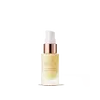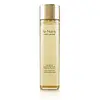What's inside
What's inside
 Key Ingredients
Key Ingredients

 Benefits
Benefits

 Concerns
Concerns

 Ingredients Side-by-side
Ingredients Side-by-side

Water
Skin ConditioningArgania Spinosa Kernel Oil
EmollientGlycerin
HumectantNiacinamide
SmoothingPolyglyceryl-10 Oleate
Skin ConditioningCaprylic/Capric Triglyceride
MaskingKojic Acid
AntioxidantCoconut Alkanes
EmollientCandelilla/Jojoba/Rice Bran Polyglyceryl-3 Esters
EmulsifyingPropanediol
SolventAnanas Sativus Fruit Extract
Skin ConditioningPterocarpus Marsupium Bark Extract
Lactobacillus Ferment
Skin ConditioningTocopherol
AntioxidantOctadecenedioic Acid
EmulsifyingCitric Acid
BufferingLactic Acid
BufferingPhosphatidylglycerol
Pentylene Glycol
Skin ConditioningSorbitan Stearate
EmulsifyingSodium Stearoyl Lactylate
EmulsifyingGlyceryl Undecylenate
EmollientCetearyl Alcohol
EmollientGlyceryl Stearate
EmollientCetyl Palmitate
EmollientCoco-Caprylate/Caprate
EmollientSaccharide Isomerate
HumectantXanthan Gum
EmulsifyingSorbitan Palmitate
EmulsifyingGlyceryl Caprylate
EmollientSorbitan Oleate
EmulsifyingSodium Hydroxide
BufferingSodium Citrate
BufferingSodium Carbonate
BufferingSodium Chloride
MaskingTetrasodium Glutamate Diacetate
Cellulose Gum
Emulsion StabilisingPhenethyl Alcohol
MaskingSodium Benzoate
MaskingWater, Argania Spinosa Kernel Oil, Glycerin, Niacinamide, Polyglyceryl-10 Oleate, Caprylic/Capric Triglyceride, Kojic Acid, Coconut Alkanes, Candelilla/Jojoba/Rice Bran Polyglyceryl-3 Esters, Propanediol, Ananas Sativus Fruit Extract, Pterocarpus Marsupium Bark Extract, Lactobacillus Ferment, Tocopherol, Octadecenedioic Acid, Citric Acid, Lactic Acid, Phosphatidylglycerol, Pentylene Glycol, Sorbitan Stearate, Sodium Stearoyl Lactylate, Glyceryl Undecylenate, Cetearyl Alcohol, Glyceryl Stearate, Cetyl Palmitate, Coco-Caprylate/Caprate, Saccharide Isomerate, Xanthan Gum, Sorbitan Palmitate, Glyceryl Caprylate, Sorbitan Oleate, Sodium Hydroxide, Sodium Citrate, Sodium Carbonate, Sodium Chloride, Tetrasodium Glutamate Diacetate, Cellulose Gum, Phenethyl Alcohol, Sodium Benzoate
Water
Skin ConditioningButylene Glycol
HumectantIsopentyldiol
HumectantDiglycerin
HumectantDipropylene Glycol
HumectantGlycerin
HumectantSwertia Chirata Extract
HumectantNarcissus Tazetta Bulb Extract
AstringentLaminaria Digitata Extract
Skin ProtectingPorphyridium Cruentum Extract
Skin ConditioningTocopheryl Acetate
AntioxidantSodium Hyaluronate
HumectantCamellia Sinensis Leaf Extract
AntimicrobialMyrtus Communis Leaf Extract
PerfumingSigesbeckia Orientalis Extract
Skin ConditioningPalmaria Palmata Extract
Skin ProtectingHydrolyzed Rice Extract
Skin ConditioningCucumis Sativus Fruit Extract
EmollientPyrus Malus Fruit Extract
Skin ConditioningScutellaria Baicalensis Root Extract
AstringentPolygonum Cuspidatum Root Extract
AntioxidantHydrolyzed Wheat Protein
Skin ConditioningSaccharomyces Lysate Extract
HumectantLactobacillus Ferment
Skin ConditioningCaffeine
Skin ConditioningCaprylyl Glycol
EmollientAcetyl Hexapeptide-8
HumectantPPG-26-Buteth-26
Skin ConditioningSucrose
HumectantDipotassium Glycyrrhizate
HumectantGold
Cosmetic ColorantSaccharum Officinarum Extract
MoisturisingGlycine Soja Protein
EmulsifyingLactis Proteinum
Skin ConditioningPearl Powder
Acetyl Glucosamine
Skin ConditioningSaccharide Isomerate
HumectantAscorbyl Glucoside
AntioxidantEthylhexylglycerin
Skin ConditioningPotassium Hydroxide
BufferingPPG-6-Decyltetradeceth-30
EmulsifyingPolymethylsilsesquioxane
Citric Acid
BufferingHexylene Glycol
EmulsifyingPEG-40 Hydrogenated Castor Oil
EmulsifyingParfum
MaskingSodium Metabisulfite
AntioxidantSodium Sulfite
PreservativeDisodium EDTA
Sodium Citrate
BufferingPotassium Sorbate
PreservativePhenoxyethanol
PreservativeWater, Butylene Glycol, Isopentyldiol, Diglycerin, Dipropylene Glycol, Glycerin, Swertia Chirata Extract, Narcissus Tazetta Bulb Extract, Laminaria Digitata Extract, Porphyridium Cruentum Extract, Tocopheryl Acetate, Sodium Hyaluronate, Camellia Sinensis Leaf Extract, Myrtus Communis Leaf Extract, Sigesbeckia Orientalis Extract, Palmaria Palmata Extract, Hydrolyzed Rice Extract, Cucumis Sativus Fruit Extract, Pyrus Malus Fruit Extract, Scutellaria Baicalensis Root Extract, Polygonum Cuspidatum Root Extract, Hydrolyzed Wheat Protein, Saccharomyces Lysate Extract, Lactobacillus Ferment, Caffeine, Caprylyl Glycol, Acetyl Hexapeptide-8, PPG-26-Buteth-26, Sucrose, Dipotassium Glycyrrhizate, Gold, Saccharum Officinarum Extract, Glycine Soja Protein, Lactis Proteinum, Pearl Powder, Acetyl Glucosamine, Saccharide Isomerate, Ascorbyl Glucoside, Ethylhexylglycerin, Potassium Hydroxide, PPG-6-Decyltetradeceth-30, Polymethylsilsesquioxane, Citric Acid, Hexylene Glycol, PEG-40 Hydrogenated Castor Oil, Parfum, Sodium Metabisulfite, Sodium Sulfite, Disodium EDTA, Sodium Citrate, Potassium Sorbate, Phenoxyethanol
Ingredients Explained
These ingredients are found in both products.
Ingredients higher up in an ingredient list are typically present in a larger amount.
Citric Acid is an alpha hydroxy acid (AHA) naturally found in citrus fruits like oranges, lemons, and limes.
Like other AHAs, citric acid can exfoliate skin by breaking down the bonds that hold dead skin cells together. This helps reveal smoother and brighter skin underneath.
However, this exfoliating effect only happens at high concentrations (20%) which can be hard to find in cosmetic products.
Due to this, citric acid is usually included in small amounts as a pH adjuster. This helps keep products slightly more acidic and compatible with skin's natural pH.
In skincare formulas, citric acid can:
While it can provide some skin benefits, research shows lactic acid and glycolic acid are generally more effective and less irritating exfoliants.
Most citric acid used in skincare today is made by fermenting sugars (usually from molasses). This synthetic version is identical to the natural citrus form but easier to stabilize and use in formulations.
Read more about some other popular AHA's here:
Learn more about Citric AcidGlycerin is already naturally found in your skin. It helps moisturize and protect your skin.
A study from 2016 found glycerin to be more effective as a humectant than AHAs and hyaluronic acid.
As a humectant, it helps the skin stay hydrated by pulling moisture to your skin. The low molecular weight of glycerin allows it to pull moisture into the deeper layers of your skin.
Hydrated skin improves your skin barrier; Your skin barrier helps protect against irritants and bacteria.
Glycerin has also been found to have antimicrobial and antiviral properties. Due to these properties, glycerin is often used in wound and burn treatments.
In cosmetics, glycerin is usually derived from plants such as soybean or palm. However, it can also be sourced from animals, such as tallow or animal fat.
This ingredient is organic, colorless, odorless, and non-toxic.
Glycerin is the name for this ingredient in American English. British English uses Glycerol/Glycerine.
Learn more about GlycerinLactobacillus Ferment is created by fermenting the Lactobacillus bacteria. It helps keep our skin's natural barrier and microbiome healthy.
Studies show lactobacillus ferment to be effective at repairing the skin barrier. Having a healthy skin barrier helps keep your skin healthy and hydrated. It also protects against bad bacteria.
As a probiotic/prebiotic/postbiotic, Lactobacillus ferment can help regular our natural biome. In fact, one study found a lack of diversity in our natural skin biome can trigger acne.
Learn more about Lactobacillus FermentSaccharide Isomerate comes from sugars found in corn. It is a skin hydrator.
The structure of this ingredient can be altered to be more similar to the carbohydrates found in our skin. This ability to mimic our skin gives it hydrating properties.
Specifically, saccharide Isomerate is a humectant. Humectants draw moisture from the air to our skin.
Research shows Saccharide Isomerate to be an effective moisturizer.
Learn more about Saccharide IsomerateSodium Citrate is the sodium salts of citric acid. In skincare, it is used to alter pH levels and acts as a preservative.
Its main functions are to maintain the pH of a product and neutralize metal ions.
The acidity of our skin is maintained by our glands and skin biome; normal pH level of skin is slightly acidic (~4.75-5.5).
Being slightly acidic allows our skin to create an "acid mantle". This acid mantle is a thin barrier that protects our skin from bacteria and contaminants.
Learn more about Sodium CitrateWater. It's the most common cosmetic ingredient of all. You'll usually see it at the top of ingredient lists, meaning that it makes up the largest part of the product.
So why is it so popular? Water most often acts as a solvent - this means that it helps dissolve other ingredients into the formulation.
You'll also recognize water as that liquid we all need to stay alive. If you see this, drink a glass of water. Stay hydrated!
Learn more about Water